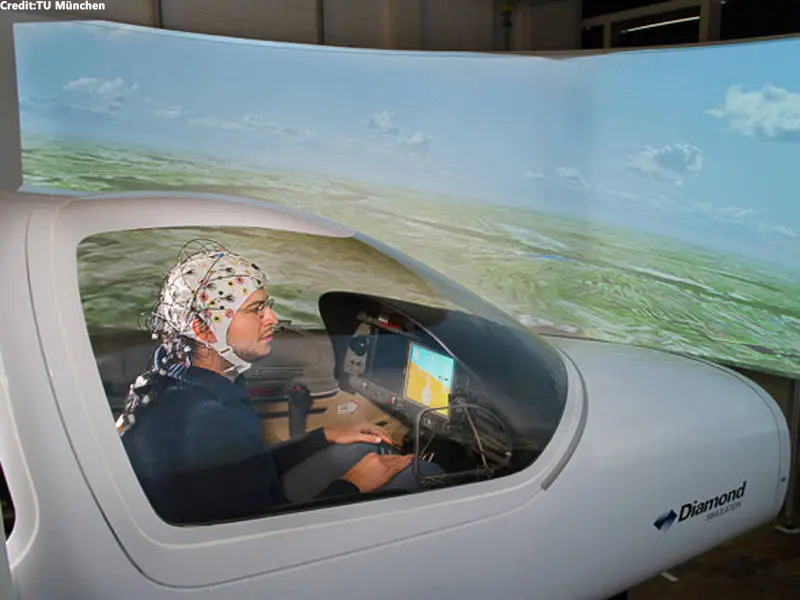Aviation
A New Era in Aviation: German Researchers Build a Plane, Controlled by the Brain

Unlocking the potential of the human mind, German researchers have achieved an astonishing feat: a plane controlled solely by the power of your thoughts. Imagine taking to the skies without ever touching a control stick, relying instead on the incredible capabilities of your brain. This groundbreaking technology heralds a new era where the boundaries of possibility are redefined, offering the exhilarating opportunity to navigate the skies
In a groundbreaking advancement, a team of researchers from Technische Universität München and TU Berlin in Germany has developed technology enabling planes to be flown using only the power of thoughts. Led by Professor Florian Holzapfel, the scientists have not only achieved this feat but have also demonstrated its remarkable precision.
Using a flight simulator, seven subjects, including one with no cockpit experience, successfully navigated virtual skies with enough accuracy to pass a flying license test. This achievement marks a significant milestone in aviation technology.
The key to this brain-to-plane communication lies in a cap outfitted with EEG electrodes, which capture signals from the subjects’ brains. These signals are then translated into commands through an algorithm developed by the TU Berlin scientists.
Tim Fricke, head of the EU-funded project Brainflight, emphasizes the long-term goal of making flying more accessible to a broader range of people. While the prospect of the Average Joe donning an EEG cap and flying a plane may still be distant, the technology holds promise for enhancing flight safety and efficiency.
During tests, pilots managed landing approaches under poor visibility conditions, demonstrating the system’s reliability. Moreover, the technology has the potential to ease the workload of pilots, allowing them more freedom to manage other tasks in the cockpit. Following successful tests, researchers are now exploring how to adapt control systems and flight dynamics to accommodate this innovative control method. With brain control, flying could become more intuitive and less physically demanding, ushering in a new era of aviation safety and accessibility.

Aviation
COMAC Unveils Plans for the C929 to Rival Airbus and Boeing

After the success of China’s first C919 aircraft, the country is setting its sights on developing a larger plane. COMAC (Commercial Aircraft Corporation of China) has officially confirmed plans to build a widebody aircraft, marking a significant step in its aircraft lineup.
Traditionally, Airbus and Boeing dominate the widebody aircraft market, with decades of expertise in developing planes and engines capable of carrying heavy payloads. China, which currently relies on imported engines, is now aiming to challenge these giants with its own widebody jet, the C929, designed to compete with the Airbus A350 and Boeing 777.
American Airlines Is Looking for Flight Attendants: Apply Now
The C929 will be China’s first independently developed long-range widebody aircraft. It adheres to international airworthiness standards and boasts independent intellectual property rights. The baseline version is designed to seat 280 passengers and offers a range of 12,000 kilometers, catering to global demand for both regional and international air travel.
Russia, which also needs reliable narrowbody and widebody aircraft, could become a key customer for the C929. Additionally, China plans to target the broader Asian market as it continues to expand its aviation capabilities.
Close Call at Heathrow: BA Flight Narrowly Escapes Drone Collision
China’s aviation progress includes the ARJ21 (now called C909), a regional jet with 100 seats for shorter routes, and the C919, a narrowbody jet with 180 seats designed to rival the Boeing 737 MAX and Airbus A320. Both models have found increasing demand in the domestic market.
At China’s largest air show in Zhuhai, COMAC announced that Air China will be the launch customer for the C929 widebody jet, though details about order size and delivery timelines were not disclosed.
Other major deals announced by COMAC include:
- Hainan Airlines: Firm orders for 60 C919 and 40 C909 regional jets.
- Colorful Guizhou Airlines: 30 C909 jets, with 20 firm orders and 10 provisional agreements.
The C929, renamed from the CR929 after Russia withdrew from the joint development project in 2023, is expected to carry 280–400 passengers with a range of 12,000 kilometers, competing directly with Boeing’s 787 Dreamliner.
According to COMAC’s deputy general manager, Tong Yu, the first fuselage section of the C929 is expected by September 2027, with prototype test flights anticipated soon after.
-

 Aviation2 months ago
Aviation2 months agoMicrosoft Flight Simulator Raises $3 Million to Bring Back the An-225 Mriya
-

 Airlines2 months ago
Airlines2 months agoQantas Engineers Stage Walkout Over Cost of Living Concerns
-

 Airlines2 months ago
Airlines2 months agoQatar Citizens Can Travel to the United States Without a Visa
-

 Aviation2 months ago
Aviation2 months agoQatar Airways bans these new Electronic Devices on plane
-

 Airlines2 months ago
Airlines2 months agoJapan Airlines Rolls Out Free Domestic Flights to International Passengers
-

 Defence2 months ago
Defence2 months agoWhich Country Has the Largest Fleet of Fighter Aircraft?
-

 Airport2 months ago
Airport2 months agoWestern Sydney Airport Welcomes Its First Plane After 6 Years of construction
-

 Aviation2 months ago
Aviation2 months agoDid you know ? Once Boeing 747 carried 1088 passenger in 1991








